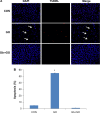Ginkgo biloba: a natural reducing agent for the synthesis of cytocompatible graphene
- PMID: 24453487
- PMCID: PMC3890967
- DOI: 10.2147/IJN.S53538
Ginkgo biloba: a natural reducing agent for the synthesis of cytocompatible graphene
Abstract
Background: Graphene is a novel two-dimensional planar nanocomposite material consisting of rings of carbon atoms with a hexagonal lattice structure. Graphene exhibits unique physical, chemical, mechanical, electrical, elasticity, and cytocompatible properties that lead to many potential biomedical applications. Nevertheless, the water-insoluble property of graphene restricts its application in various aspects of biomedical fields. Therefore, the objective of this work was to find a novel biological approach for an efficient method to synthesize water-soluble and cytocompatible graphene using Ginkgo biloba extract (GbE) as a reducing and stabilizing agent. In addition, we investigated the biocompatibility effects of graphene in MDA-MB-231 human breast cancer cells.
Materials and methods: Synthesized graphene oxide (GO) and GbE-reduced GO (Gb-rGO) were characterized using various sequences of techniques: ultraviolet-visible (UV-vis) spectroscopy, Fourier-transform infrared spectroscopy (FTIR), dynamic light scattering (DLS), scanning electron microscopy (SEM), atomic force microscopy (AFM), and Raman spectroscopy. Biocompatibility of GO and Gb-rGO was assessed in human breast cancer cells using a series of assays, including cell viability, apoptosis, and alkaline phosphatase (ALP) activity.
Results: The successful synthesis of graphene was confirmed by UV-vis spectroscopy and FTIR. DLS analysis was performed to determine the average size of GO and Gb-rGO. X-ray diffraction studies confirmed the crystalline nature of graphene. SEM was used to investigate the surface morphologies of GO and Gb-rGO. AFM was employed to investigate the morphologies of prepared graphene and the height profile of GO and Gb-rGO. The formation of defects in Gb-rGO was confirmed by Raman spectroscopy. The biocompatibility of the prepared GO and Gb-rGO was investigated using a water-soluble tetrazolium 8 assay on human breast cancer cells. GO exhibited a dose-dependent toxicity, whereas Gb-rGO-treated cells showed significant biocompatibility and increased ALP activity compared to GO.
Conclusion: In this work, a nontoxic natural reducing agent of GbE was used to prepare soluble graphene. The as-prepared Gb-rGO showed significant biocompatibility with human cancer cells. This simple, cost-effective, and green procedure offers an alternative route for large-scale production of rGO, and could be used for various biomedical applications, such as tissue engineering, drug delivery, biosensing, and molecular imaging.
Keywords: Fourier-transform infrared spectroscopy; Raman spectroscopy; UV-visible spectroscopy; alkaline phosphatase activity; atomic force microscopy; biocompatibility; cell viability; graphene; scanning electron microscopy.
Figures











Similar articles
-
A Novel Biomolecule-Mediated Reduction of Graphene Oxide: A Multifunctional Anti-Cancer Agent.Molecules. 2016 Mar 18;21(3):375. doi: 10.3390/molecules21030375. Molecules. 2016. PMID: 26999102 Free PMC article.
-
An in vitro evaluation of graphene oxide reduced by Ganoderma spp. in human breast cancer cells (MDA-MB-231).Int J Nanomedicine. 2014 Apr 8;9:1783-97. doi: 10.2147/IJN.S57735. eCollection 2014. Int J Nanomedicine. 2014. PMID: 24741313 Free PMC article.
-
Green chemistry approach for the synthesis of biocompatible graphene.Int J Nanomedicine. 2013;8:2719-32. doi: 10.2147/IJN.S45174. Epub 2013 Jul 31. Int J Nanomedicine. 2013. PMID: 23940417 Free PMC article.
-
Bio-reduction of Graphene Oxide: Catalytic Applications of (Reduced) GO in Organic Synthesis.Curr Org Synth. 2020;17(3):164-191. doi: 10.2174/1570179417666200115110403. Curr Org Synth. 2020. PMID: 32538718 Review.
-
Synthesis and Functionalization of Graphene Materials for Biomedical Applications: Recent Advances, Challenges, and Perspectives.Adv Sci (Weinh). 2023 Mar;10(9):e2205292. doi: 10.1002/advs.202205292. Epub 2023 Jan 19. Adv Sci (Weinh). 2023. PMID: 36658693 Free PMC article. Review.
Cited by
-
Bioinspired graphene-based metal oxide nanocomposites for photocatalytic and electrochemical performances: an updated review.Nanoscale Adv. 2024 Apr 5;6(10):2539-2568. doi: 10.1039/d3na01071f. eCollection 2024 May 14. Nanoscale Adv. 2024. PMID: 38752147 Free PMC article. Review.
-
A Novel Biomolecule-Mediated Reduction of Graphene Oxide: A Multifunctional Anti-Cancer Agent.Molecules. 2016 Mar 18;21(3):375. doi: 10.3390/molecules21030375. Molecules. 2016. PMID: 26999102 Free PMC article.
-
Synthesis, toxicity, biocompatibility, and biomedical applications of graphene and graphene-related materials.Int J Nanomedicine. 2016 May 5;11:1927-45. doi: 10.2147/IJN.S105264. eCollection 2016. Int J Nanomedicine. 2016. PMID: 27226713 Free PMC article. Review.
-
Silver-doped graphene oxide nanocomposite triggers cytotoxicity and apoptosis in human hepatic normal and carcinoma cells.Int J Nanomedicine. 2018 Sep 24;13:5685-5699. doi: 10.2147/IJN.S165448. eCollection 2018. Int J Nanomedicine. 2018. PMID: 30288041 Free PMC article.
-
Identifying the Anti-MERS-CoV and Anti-HcoV-229E Potential Drugs from the Ginkgo biloba Leaves Extract and Its Eco-Friendly Synthesis of Silver Nanoparticles.Molecules. 2023 Feb 1;28(3):1375. doi: 10.3390/molecules28031375. Molecules. 2023. PMID: 36771041 Free PMC article.
References
-
- Novoselov KS, Geim AK, Morozov SV, et al. Electric field effect in atomically thin carbon films. Science. 2004;306(5696):666–669. - PubMed
-
- Wang Y, Shi Z, Yin J. Facile synthesis of soluble graphene via a green reduction of graphene oxide in tea solution and its biocomposites. ACS Appl Mater Interfaces. 2011;3(4):1127–1133. - PubMed
-
- Geim KA, Novoselov KS. The rise of graphene. Nat Mater. 2007;6(3):183–191. - PubMed
-
- Rao CNR, Sood AK, Subrahmanyam KS, Govindaraj A. Graphene: the new two-dimensional nanomaterial. Angew Chem Int Ed Engl. 2009;48(42):7752–7777. - PubMed
-
- Allen MJ, Tung VC, Kaner RB. Honeycomb carbon: a review of graphene. Chem Rev. 2010;110:132–145. - PubMed
Publication types
MeSH terms
Substances
LinkOut - more resources
Full Text Sources
Other Literature Sources
Medical
Miscellaneous

